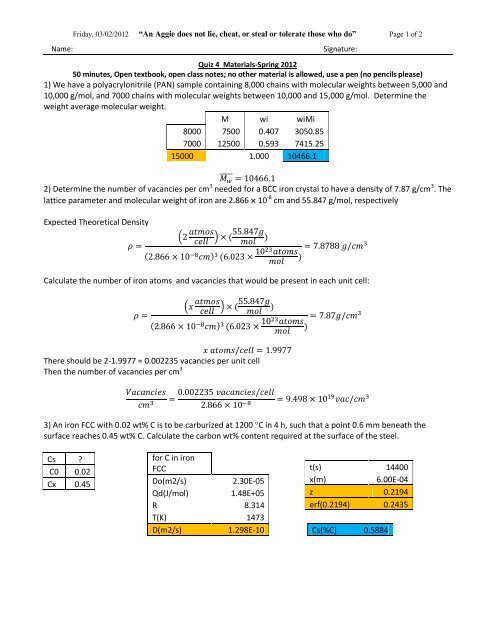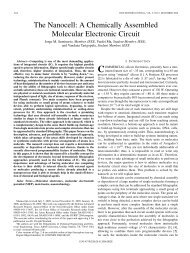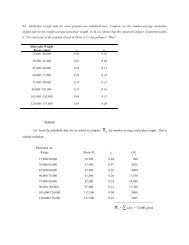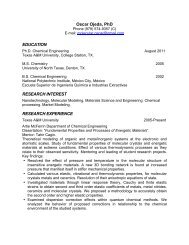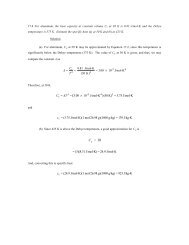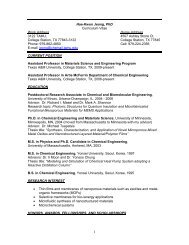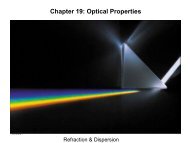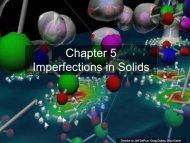You also want an ePaper? Increase the reach of your titles
YUMPU automatically turns print PDFs into web optimized ePapers that Google loves.
Name:<br />
Friday, 03/02/2012 “An Aggie does not lie, cheat, or steal or tolerate those who do” Page 1 of 2<br />
Signature:<br />
Quiz 4 Materials-Spring 2012<br />
50 minutes, Open textbook, open class notes; no other material is allowed, use a pen (no pencils please)<br />
1) We have a polyacrylonitrile (PAN) sample containing 8,000 chains with molecular weights between 5,000 and<br />
10,000 g/mol, and 7000 chains with molecular weights between 10,000 and 15,000 g/mol. Determine the<br />
weight average molecular weight.<br />
M wi wiMi<br />
8000 7500 0.407 3050.85<br />
7000 12500 0.593 7415.25<br />
15000 1.000 10466.1<br />
̅̅̅̅̅<br />
2) Determine the number of vacancies per cm 3 needed for a BCC iron crystal to have a density of 7.87 g/cm 3 . The<br />
lattice parameter and molecular weight of iron are 2.866 10 -8 cm and 55.847 g/mol, respectively<br />
Expected Theoretical Density<br />
( )<br />
Calculate the number of iron atoms and vacancies that would be present in each unit cell:<br />
( )<br />
There should be 2-1.9977 = 0.002235 vacancies per unit cell<br />
Then the number of vacancies per cm 3<br />
3) An iron FCC with 0.02 wt% C is to be carburized at 1200 C in 4 h, such that a point 0.6 mm beneath the<br />
surface reaches 0.45 wt% C. Calculate the carbon wt% content required at the surface of the steel.<br />
Cs <br />
C0 0.02<br />
Cx 0.45<br />
for C in iron<br />
FCC<br />
Do(m2/s)<br />
2.30E-05<br />
Qd(J/mol)<br />
1.48E+05<br />
R 8.314<br />
T(K) 1473<br />
D(m2/s)<br />
1.298E-10<br />
t(s) 14400<br />
x(m)<br />
6.00E-04<br />
z 0.2194<br />
erf(0.2194) 0.2435<br />
Cs(%C) 0.5884
Friday, 03/02/2012 “An Aggie does not lie, cheat, or steal or tolerate those who do” Page 2 of 2<br />
4) For a given material, plastic deformation begins with a stress of 400 MPa and the modulus of elasticity is 150<br />
GPa. For a specimen with a cross-sectional area of 200 mm 2 and 90 mm long, what is the maximum length to<br />
which it may be stretched without causing plastic deformation


